Table of Contents
Green Spotted Puffer
The average Green Spotted Puffer may reach a height of 6 inches. Despite not being huge, they are more than a match for their size due to their aggressive temperament. They need a tank that is 35 to 50 gallons in size. You can keep the youngsters in a smaller tank. You’ll need a strong filter to keep a green spotted puffer in a tank since they produce a lot of waste after they eat.
Green Spotted Puffer Overview
The Green Spotted Puffer has unique demands and requires special care. Their speckled yellow-green backs make them appealing for home tanks, and their distinct mannerisms set them apart from almost any other fish you’ve ever had. Green Spotted Puffers are an excellent example of why it’s vital to do your research before bringing a new aquarium fish home. Failure to do so in this scenario may result in the death of your puffer and possibly all of the other fish in your tank.
The green spotted puffer has an uncanny resemblance with the frog and leopard. If a part of this fish is hidden and the back exposed, one may confuse it with a frog of a strange kind. Well, these are some of the marvels of Mother Nature worth exploring. At least this gives one reason to keep puffer fish in an aquarium.
This guide will help you realize if the Green Spotted Puffer Fish is a suitable addition to your tank.
| Information Chart | Green Spotted Puffer |
| Scientific Name: | Tetraodon Nigroviridis |
| Family: | Tetraodontidae |
| Care Level: | Difficult |
| Temperament: | Aggressive |
| Color: | Green and Yellow |
| Lifespan: | 10-15 years |
| Size: | 6 inches |
| Diet: | Omnivorous, Predator |
| Minimum Tank Size: | 35 to 50 Gallons |
| Temperature: | 78 and 82 Fahrenheit |
| Water
Conditions: |
pH 7.5 to 8.2 |
| Tank Mate Compatibility | Non-Community |
Green Spotted Puffer Appearance
Scientifically known as Tetraodon Nigroviridis, the green spotted puffer fish has a spotted back resembling that of a leopard. The body of the Spotted Green Puffer is robust and rounded, with tiny spines. The face is appealing with a bit of mouth, slightly bulging eyes, and a broad forehead. The Spotted Green Puffer has a wide range of colors. The black spots on a green, almost yellow back are a sharp contrast to the white abdomen. The adult fish has a lovely bright green with brown dots and a whitish belly. Green is less vibrant in youngsters. The fish also recognizes its owner. It is likely to react as soon as a familiar face sets foot next to the tank.

It has a strong jaw instead of the usual fish teeth. There are 4 teeth-like structures it uses for crushing. Although the fish lacks pelvic fins, it is extremely maneuverable thanks to its powerful pectoral fins. This allows it to swim backward and hover over objects in the water. This fish is able to balloon as the spines jut outwards to warn an enemy in advance. In its flesh is a poisonous substance that can kill a predator that eats it.
Lifespan of Green Spotted Puffer
The typical lifespan of a Green Spotted Puffer is 10 years. If they’re kept in the appropriate tank conditions, they can live for a long time. Some even make it to the age of fifteen. Subpar treatment, on the other hand, may cause them to die too soon. Nonetheless, you may count on a long period of friendship with the tenacious little one.
Green Spotted Puffer Size
The typical Green Spotted Puffer grows upto 6 inches. While not enormous, their aggressive behavior, mentioned further down, makes them more than a match for their size.
Natural Habitat and Origin
In 1822, the Green Spotted Puffer was initially described. Fish habitat is found in Africa and Asia, and its range extends from Sri Lanka to northern China. They can be found in rivers, flooded plains, and mangroves, and they can live in both fresh and brackish water. You can also find them in India and the Philippines. The fish is also known as leopard pufferfish. It can be found in freshwater and brackish lagoons, streams, rivers, and floodplains. It can be found in schools or alone. Snails, crustaceans, and other spineless creatures, as well as plants, are eaten by Puffer. They are born during the rainy season.
Green Spotted Puffer Tank Set-Up
Green Spotted Puffer tank size and specifications
Optimum Tank Size for Green Spotted Puffer
The recommended tank size for the Green Spotted Puffer is 35 to 50 gallons. The juveniles, on the other hand, can be kept in a smaller tank. When maintaining a green spotted puffer in a tank, you’ll need a powerful filter because they leave a lot of waste after they eat.
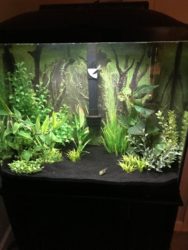
Tank Shape for Green Spotted Puffer
You would not have to worry about the tank shape for your Puffer if the tank size is perfect. To make greater room for your Puffers, it is always better to have a rectangular tank. Such a tank would give them more room to swim around.
Filter Type
It’s good to install a canister filter that can pump 5-10 tank capacities each hour. Remember to refresh your water every week. About 30% water renewal is recommended. The water should be lightly salted. For 20 liters of water, one tablespoon of salt is enough.
Substrate
While standard gravel substrate is adequate, some keepers prefer crushed coral to maintain the proper pH levels in the tank water. As with any aquarium, it’s a good idea to have a water-testing kit on hand to ensure you’re on the right track. Sand and Gravel are the best substrate options for your Puffers.
How many puffers in a 35-50 gallon tank?
Green Spotted Puffers are large, powerful fish that need a lot of room to thrive. The recommended tank size for a single puffer is 30 gallons, even though they only grow to be about six inches long as adults. However, 55 gallons is preferable because it gives your fish plenty of room to swim and explore.
Water Parameters for Green Spotted Puffers
Water Temperature
The ideal water temperature for the Green Spotted Puffer is 78 and 82 Fahrenheit. They must be adhered to in a consistent and severe manner. Many businesses will try to pass them off as freshwater fish, despite the fact that this is not the case.
Water Flow Rate
The Green Spotted Puffers live in brackish waters in the natural habitat. Hence, it is important to keep the water flow rate in the tank at a moderate level. Keeping a high flow rate will be uncomfortable for your Puffers.
pH Level
The perfect water pH level for Green Spotted Puffer is 7.5 to 8.2. The Green Spotted Puffer can be difficult to keep since their water requirements change as they grow older. They can endure a freshwater habitat as a youngster. They need a brackish marine environment to thrive as they grow older. To ensure health and long life, juvenile Green Spotted Puffers should have salinity levels of 1.005-1.008. The adults should have salinity levels of 1.018-1.022.. You’ll also require a supply of sea salt. A hydrometer is one of the most crucial pieces of equipment you’ll need. These are low-cost gadgets that test the salinity of your tank water. These are essential for ensuring you’re providing your fish with the correct brackish environment.
Water Hardness
The water hardness level for the Green Spotted Puffer tank should be at dGH 6-18.
A low-ammonia and low-nitrate environment is required for green pufferfish. To do so, you’ll need a water testing kit. Ammonia and nitrate levels in the water can be harmful to your fish’s health.
Green Spotted Puffer Tank Landscape
Best Plants for Green Spotted Puffer Tank
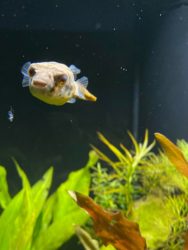
Java Ferns
This delicate-looking fern gives aquariums a lovely appearance. It’s popular because of its sluggish growth, distinctive shape, and simplicity of propagation and care. It may be kept with a wide variety of species and does not require stringent water requirements, which is why so many people find it interesting. Beginners will find them to be one of the easiest plants to grow. The Java Fern will add beauty to your Puffers tank.
Dwarf Sagittaria
Dwarf Sagittaria is a beautiful accessory to any planted aquarium. This aquatic plant is resilient and forgiving in various water parameters. It is easy to grow, even for amateurs. Dwarf Sagittaria is a fast-growing plant that thrives in both complete and partial submergence. You’ll love watching Dwarf Sagittaria’s leaves emerge above the water’s surface and seeing your aquarium companions bask in the shade of this luscious plant. Live plants provide a certain zing to a communal tank that artificial plants cannot match. These plants are a perfect addition to your Puffer tanks!
Anubias
The freshwater aquarium plant Anubias is one of the most popular and hardy. The good news is that Anubias is a hardy plant, making it an excellent choice for novice gardeners. The broad rhizome, strong root structure, and long-lasting green leaves of Anubias are all notable features. Anubias can be used as foreground, middle ground, or background plant, depending on the cultivar. In any case, it can provide an aquarium with a long-lasting splash of lush green color. These plants will make your tank lively and beautiful.
Worst Plants for Green Spotted Puffer Tank
Plants that cannot survive in the required water conditions of a Puffer tank should be avoided at all costs. These plants will have the tendency to wither away and leave its residues in the tank. These residues can potentially worsen the water conditions of the tank. Hence, always look for plants that can survive in brackish waters for your Puffer fish tank.
Decorations for Green Spotted Puffer Tank
GSPs might get bored with their surroundings. They can be revitalised by moving or replacing their decor. It’s a good idea to provide them with a number of hiding locations and barriers to break up their line of sight. Caves with enough hiding spots will be a perfect addition to your tank. Make sure there are plenty of plants and rockwork for retreats, as well as open swimming areas. These puffers are excellent jumpers and require a lid that is completely enclosed. It’s always a good idea to include a lot of caverns, twisted root plants, boulders, and other decor to block the puffer’s line of sight and establish territorial borders.
Lighting for Green Spotted Puffer Tank
There are no special requirements for lighting up a Green Spotted Puffer Fish tank. Any basic aquarium lighting will do the job. However, make sure that the lights aren’t too bright. Extremely bright lights can be uncomfortable for your Puffers.
Feeding Green Spotted Puffer
Best Diet for Green Spotted Puffer
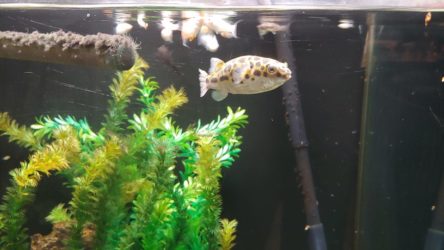
All fishes like Flake food. The Green Spotted Puffer is an exception to this rule. It feeds on meaty foods such as krill and bloodworms. Before serving this food to the fish, it should be thawed in tank water. If you don’t give it enough, the rest will go to waste. A hunter, the green spotted puffer is well-known. Shrimp is a good addition because it makes it work harder. Frozen food does not have this nutritional value. To keep the fish happy, it would be helpful if you remembered to vary these meals. They eat crustaceans in the wild, with snails being a favorite. Include hard-shelled creatures in its diet. A bony plate grows in the fish’s mouth as long as the animal is alive. To slow their growth, the fish must eat hard items to wear down the plate. If this fails to happen, they are likely to be incapacitated to the extent that they cannot eat. This could eventually lead to their death. Snails are a favorite for the Green Spotted Puffer. Stock the tank with these as much as possible. To avoid running out of snails, an individual can breed them. They are easy to grow in a separate pond because keeping them in the same one as the Green Spotted Puffer can be futile. During feeding times, keep in mind the fact that the fish is poisonous. Touching it with bare hands is not recommended either.
How often should you feed a Green Spotted Puffer?
Your Green Spotted Puffer can eat every day when it is a newborn, but as it becomes bigger, you should switch to an alternate day feed/fast regimen.
Green Spotted Puffer Behavior and Temperament
Are Green Spotted Puffer Fish Lone or Societal in Nature?
The Green Spotted Puffer, like all pufferfish, varies widely in temperament from one individual to the next. They’re known for being aggressive fin-nippers and are frequently kept alone. They can, however, be housed in a community with other members of their species as well as large, non-aggressive animals. If you’re in a community aquarium, make sure there’s enough space and that the tank is well-planted. Other decorations, such as rocks and roots, can be added. Place the decor in such a way that it disrupts their line of sight and provides plenty of hiding places for the fish. Don’t be deceived by a juvenile puffer’s hesitant and timid behavior if you try to introduce one to your community tank. There’s a vicious streak in these tiny fellas. Very soon, their instinct kicks in, and fish start to vanish. Larger, semi-aggressive tank mates have worked for some folks, but there is no guarantee. Long-finned, slow-swimming fish should never be introduced since they will become instant targets for your puffer. Although the Green Spotted Puffer is not a shoaling fish, it is usually tolerant of its kind. As a result, a mono-species tank is usually the best option.
Green Spotted Puffer Fish Tank Mates
Ideal Tank Mates for Green Spotted Puffer Fish
You might choose to keep an aquarium with a variety of fish species, both large and tiny, in a variety of colors, swimming about like an underwater rainbow. That fantasy will have to wait, or at the very least, will necessitate a replacement fish tank. Because of the Green Puffer’s fury and bloodlust, this is the case. If that seems like a medieval ward lord’s description, it’s because it is. Any other organism in the tank, such as other fish or insects, will be eaten by the puffer. You could believe that keeping it with one of its kind will keep its bloodlust at bay, but you’d be mistaken. It consumes other Pufferfish as well. They can even get along with other pufferfish for a while before eating them when they show signs of frailty. When you put a Green Puffer in with the other fish, they’d shout at the top of their lungs if they could talk. They would call them killers. There are some exceptions to the rule. Bumblebees, Mollies, Archerfish, Scats, and other Green Spotted Pufferfish can all be put in with them. If they’re consumed, remember that we warned you!
Bad Tank Mates for Green Spotted Puffers
As mentioned above, it is better to keep these violent creatures alone in the Tanks. Their predatory instincts can pose to other species in your tank. You must avoid timid and peaceful species since they’d be more vulnerable in the tank.
Breeding Green Spotted Puffer Fish
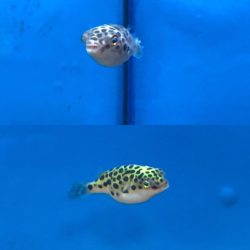
Like several fish or sea animals, distinguishing between males and females is quite tricky. This makes breeding a little technical. All the same, some people have been successful in breeding them.
One way of breeding is having more than five of these fish in a tank. This increases the chances of mixed sexes. After identifying a female, which will probably become huge after breeding, it can be set for conducive conditions for spawning. These are:
- It spawns in brackish waters that a hobbyist can provide
- At the time of spawning, flat rocks can provide a potential surface for spawning.
- After the female lays the eggs on a rigid substrate or flat rocks, the male guards these eggs
- The eggs hatch after about seven days. The fry is then moved to a pit where the male continues guarding them.
- Raising the fry is very challenging. The fry does not readily consume most foods at this stage. This calls for feeding by use of Cyclops Nauplii.
Green Spotted Puffer Breeding Level- Hard
Green Spotted Puffer Sexual Dimorphism
It’s still a mystery how to tell the difference between male and female Green Spotted Puffers.
Green Spotted Puffers common diseases and their treatment
The Green Spotted Puffer lacks gill coverings and scales, making it more susceptible to disease. Puffers are the first fish in a tank to show signs of ick, twitching, and rubbing their way around the tank. Most medications work well on them, and they usually heal fast. Copper should never be used in a Puffer tank. Another typical problem, though not a sickness, is Puffer’s teeth, which increase if not worn down or cut, leading to overgrowth and hunger. Even when feeding snails and other shelled foods in an aquarium, there’s a good chance you’ll have to trim their teeth. This sounds a lot worse than it is. Place the puffer in a container of water without exposing it to the air to do this.You can sedate the water with three drops of clove oil. This will allow you to hold it in your hand more comfortably. Cuticle clippers are required; use these to clip the bottom and upper teeth. After that, place the puffer in a container or net where the current will run over them. Return to the tank once you’ve regained consciousness. Because the Green Spotted Puffer is taken in the wild, it may contain parasites. So, if it hasn’t already been done, deworming is a good idea.
Facts about Green Spotted Puffers
- This fish does not have scales hence prone to illness.
- Green Spotted Puffer is an aggressive fish that cannot safely share a tank with others, more so smaller species.
- Since it has a poisonous substance, it can harm the other tank mates too. If possible therefore, keep green spotted puffer fish by themselves.
- The fish eats quite a lot. In fact, this fish in the wilds spends a lot of its time hunting for food. Over-feeding it in captivity can be disastrous as it becomes too fat and may eventually die.
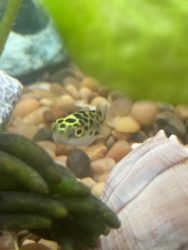
Are Green Spotted Puffers right for you?
As you mentioned above, owning and caring for a green spotted puffer requires a little more time and effort than owning and caring for any other aquarium fish. You must ensure that it has the proper tank setup, water conditions, and food, and if you fail to do so, the puffer may perish.
Don’t let any of this deter you if you genuinely believe a Green Spotted Puffer is the fish for you. They are one of the most gratifying and fun fish to own, and the extra effort is well worth it. If you’re new to fishkeeping, though, a betta fish or other tropical species would be an excellent place to start. Good luck to those who are prepared to care for their Green Spotted Puffer!
FAQ
Are green spotted puffer fish poisonous?
Because of the toxic compounds they produce, the green spotted puffer is poisonous to humans and other animals.
What happens to a fish if they try to eat a dead Green Spotted Puffer?
The Green Spotted Puffers are poisonous species. Hence, a fish would die if they tried to eat a dead Green Spotted Puffer.
How to make a green spotted puffer fish puff up?
The Green Spotted Puffer will puff up at the sight of an enemy or any sort of threats.
How to treat a green spotted puffer with ich?
Wait 24 hours after dosing Ich-X according to the instructions. You will need 5 ml of medication per 10 gallons of aquarium water. Change one-third of the water and redose the aquarium with 5 ml of Ich-X per 10 gallons of water at the same concentration.
Are puffer fish legal to own?
Yes, it is legally permissible to own a Green Spotted Puffer.
Conclusion
Green spotted puffers make excellent pets and provide a lot of enjoyment. They are among the most intelligent fish available, and their personalities are more like those of dogs than fish. With proper care and attention, these fish may provide a lifetime of companionship to their owners.
No related posts.
